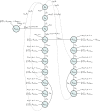Wolbachia incompatible insect technique program optimization over large spatial scales using a process-based model of mosquito metapopulation dynamics
- PMID: 39574078
- PMCID: PMC11580355
- DOI: 10.1186/s12915-024-02070-1
Wolbachia incompatible insect technique program optimization over large spatial scales using a process-based model of mosquito metapopulation dynamics
Abstract
Background: Wolbachia incompatible insect technique (IIT) programs have been shown in field trials to be highly effective in suppressing populations of mosquitoes that carry diseases such as dengue, chikungunya, and Zika. However, the frequent and repeated release of Wolbachia-infected male mosquitoes makes such programs resource-intensive. While the need for optimization is recognized, potential strategies to optimize releases and reduce resource utilization have not been fully explored.
Results: We developed a process-based model to study the spatio-temporal metapopulation dynamics of mosquitoes in a Wolbachia IIT program, which explicitly incorporates climatic influence in mosquito life-history traits. We then used the model to simulate various scale-down and redistribution strategies to optimize the existing program in Singapore. Specifically, the model was used to study the trade-offs between the intervention efficacy outcomes and resource requirements of various release program strategies, such as the total number of release events and the number of mosquitoes released. We found that scaling down releases in existing sites from twice a week to only once a week yielded small changes in suppression efficacy (from 87 to 80%), while requiring 44% fewer mosquitoes and release events. Additionally, redistributing mosquitoes from already suppressed areas and releasing them in new areas once a week led to a greater total suppressive efficacy (83% compared to 61%) while also yielding a 16% and 14% reduction in the number of mosquitoes and release events required, respectively.
Conclusions: Both scale-down and redistribution strategies can be implemented to significantly reduce program resource requirements without compromising the suppressive efficacy of IIT. These findings will inform planners on ways to optimize existing and future IIT programs, potentially allowing for the wider adoption of this method for mosquito-borne disease control.
Keywords: Aedes aegypti; Wolbachia; Compartmental model; Incompatible insect technique; Mosquitoes; Neglected tropical diseases; Simulation.
© 2024. The Author(s).
Conflict of interest statement
Declarations. Ethics approval and consent to participate: Not applicable. Consent for publication: Not applicable. Competing interests: We would like to declare that the primary author, Preston Lim, is an employee of Verily Life Sciences, which produces Wolbachia mosquitoes for mosquito control programs. However, he is pursuing this research in the capacity of his PhD studentship with the National University of Singapore. The opinions expressed in this article are those of the individual authors, and do not reflect those of the primary author’s employer (Verily Life Sciences LLC).
Figures








Similar articles
-
Effectiveness of Wolbachia-mediated sterility coupled with sterile insect technique to suppress adult Aedes aegypti populations in Singapore: a synthetic control study.Lancet Planet Health. 2024 Sep;8(9):e617-e628. doi: 10.1016/S2542-5196(24)00169-4. Lancet Planet Health. 2024. PMID: 39243778
-
Strategies to Mitigate Establishment under the Wolbachia Incompatible Insect Technique.Viruses. 2022 May 24;14(6):1132. doi: 10.3390/v14061132. Viruses. 2022. PMID: 35746601 Free PMC article.
-
Modelling the Wolbachia incompatible insect technique: strategies for effective mosquito population elimination.BMC Biol. 2020 Nov 6;18(1):161. doi: 10.1186/s12915-020-00887-0. BMC Biol. 2020. PMID: 33158442 Free PMC article.
-
Innovative sterile male release strategies for Aedes mosquito control: progress and challenges in integrating evidence of mosquito population suppression with epidemiological impact.Infect Dis Poverty. 2024 Dec 3;13(1):91. doi: 10.1186/s40249-024-01258-5. Infect Dis Poverty. 2024. PMID: 39627857 Free PMC article. Review.
-
Mission Accomplished? We Need a Guide to the 'Post Release' World of Wolbachia for Aedes-borne Disease Control.Trends Parasitol. 2018 Mar;34(3):217-226. doi: 10.1016/j.pt.2017.11.011. Epub 2018 Jan 23. Trends Parasitol. 2018. PMID: 29396201 Review.
Cited by
-
Wolbachia Screening in Aedes aegypti and Culex pipiens Mosquitoes from Madeira Island, Portugal.Insects. 2025 Apr 15;16(4):418. doi: 10.3390/insects16040418. Insects. 2025. PMID: 40332988 Free PMC article.
-
Wolbachia: A bacterial weapon against dengue fever- a narrative review of risk factors for dengue fever outbreaks.New Microbes New Infect. 2025 Mar 8;65:101578. doi: 10.1016/j.nmni.2025.101578. eCollection 2025 Jun. New Microbes New Infect. 2025. PMID: 40176883 Free PMC article. Review.
References
-
- Vector-borne diseases. World Health Organization. https://www.who.int/News-Room/Fact-Sheets/Detail/Vector-Borne-Diseases. Accessed 2 May 2024.
-
- A global brief on vector-borne diseases. World Health Organization. https://iris.who.int/handle/10665/111008. Accessed 2 May 2024.
-
- Bourtzis K, Dobson SL, Xi Z, Rasgon JL, Calvitti M, Moreira LA, et al. Harnessing mosquito–Wolbachia symbiosis for vector and disease control. Acta Trop. 2014;132:S150–63. - PubMed
-
- Moreira LA, Iturbe-Ormaetxe I, Jeffery JA, Lu G, Pyke AT, Hedges LM, et al. A Wolbachia Symbiont in Aedes aegypti Limits Infection with Dengue, Chikungunya, and Plasmodium. Cell. 2009;139(7):1268–78. - PubMed
MeSH terms
LinkOut - more resources
Full Text Sources

